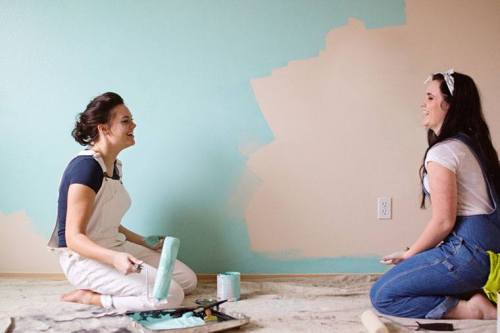The paint color that you choose for your home is a deeply personal thing. Introverts might find ways to express themselves through minimal hues, while extroverts might look for something more bold. It’s difficult to assign a definitive mood or meaning to a particular shade, since preference plays into people’s perception of colors so much. It’s safe to say, however, that a paint color means something to the person who chooses it.
“An important thing to think about when you’re looking at paint colors is your emotional response,” says Manhattan-based Elana Kilkenny, who does intuitive readings and sacred space design. “How do you want to feel in an individual room?”
Some colors are naturally assumed to have an energizing or calming influence. Yellow and orange, for instance, are considered invigorating, while blues and natural-looking greens tend to elicit a calmer response. “There’s a reason pink made such a resurgence,” says Kilkenny. “It can feel feminine, hopeful, and fresh, or incredibly bold when we get into the fuchsias.” So, while definitions of what colors mean vary from person to person, there are a few vibes to consider when choosing the hue for your bathroom or kitchen.
Keep scrolling to see if it’s time to move forward with that bright purple bedroom.
The bedroom
“It’s easy to get too yin or too yang in the bedroom,” says Kilkenny. “You need to find some kind of balance in the overall color palette. You want the color to be relaxing enough to sleep well in, but also have some sensuality.” If you love bold colors like red or purple, the best way to bring that color into the room may be through furniture and fabric (layering textures can make all the difference). Kilkenny suggests trying a calmer, lighter tone on walls, which can be made a lot more inviting when paired with colorful pillows and throws.
The kitchen
While many lean towards more neutral or nature-inspired colors when it comes to the kitchen, Kilkenny suggests looking at the things you want to change or highlight. “You can get really stuck on unchangeable tiles and appliances,” she says. To deal, pick a color that neutralizes something you don’t love or works with it rather than against it.
To reimagine some unalterable, ’80s-era pink cabinets in a client’s kitchen, Kilkenny went bold. “[I once] used a Benjamin Moore fuchsia color to create a deep pink kitchen,” she tells me. “White would have looked like a Miami Vice episode.” While you might not be in the market for a fuchsia kitchen, the takeaway is quite simply: Work with what you’ve got.
The bathroom
This is the one room Kilkenny quickly leaned toward white. It’s a crisp, clean color, but most importantly it doesn’t skew the light, which makes it a breeze to put on makeup.
The hallways
Even the smallest passageways (looking at you, New York apartments) can be made bolder with color (and truth be told, smaller spaces can often be the place for ultra-bold hues). “There’s such a great opportunity there that people sometimes miss,” says Kilkenny. “Take something that may feel kind of repressing or boring and make it interesting to you visually.”
The home as a whole
While it’s tempting choose color on a room-by-room basis, don’t lose sight of how everything fits together. “You have to think of the progression of colors, and how that evokes a story or feelings, in addition to how it looks visually,” says Kilkenny. “Some of the most amazing homes I’ve been in or designed for…the colors just worked together even if they didn’t make sense on paper.”
If you’re seriously in the market to re-paint your room, these are the hues that will make any room look bigger, but if a smaller change is in order, try introducing one of these very hard-to-kill plants into your space.
Sign Up for Our Daily Newsletter
Get all the latest in wellness, trends, food, fitness, beauty, and more delivered right to your inbox.
Got it, you've been added to our email list.










